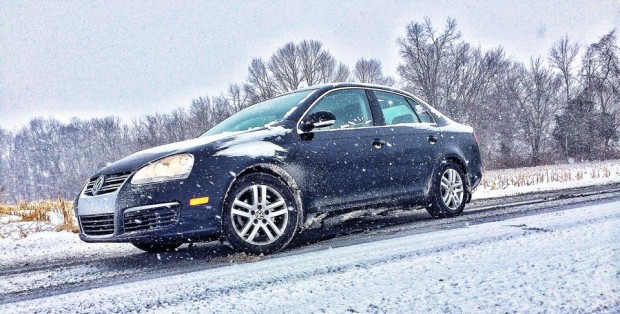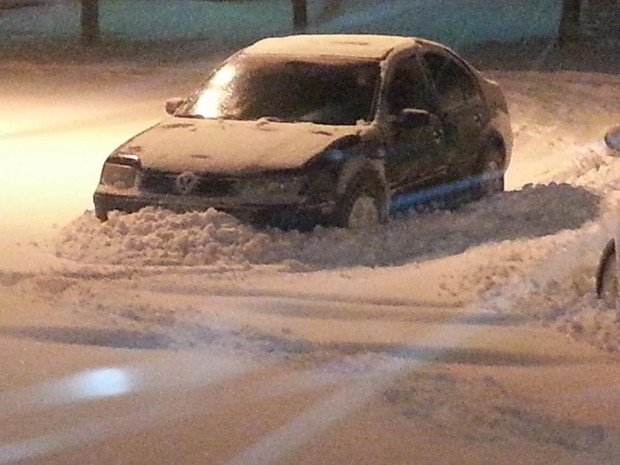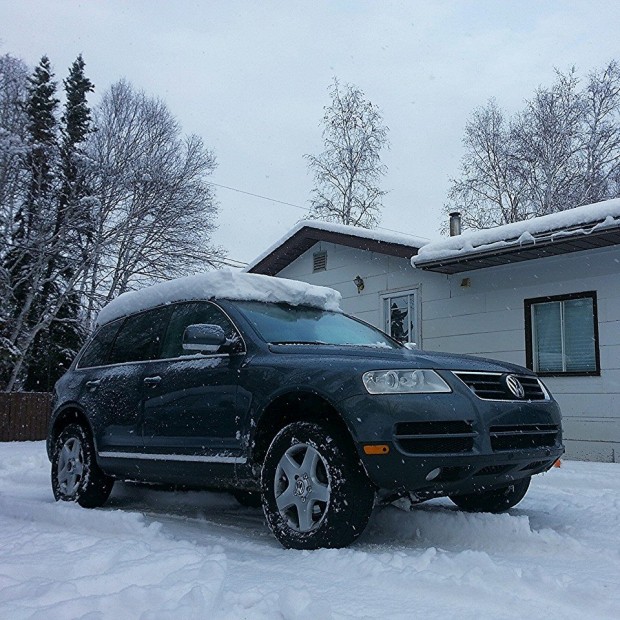Winter time is here and the season of hard starts is upon us. Thankfully new TDIs aren’t as hard to start as older IDIs or larger diesels can be but I thought it would be a good time to go over some basic winter starting tips to help make our mornings easier. Some of these tips seem obvious to seasoned vets but to someone new to diesel Volkswagens they may be things that they haven’t thought of yet.
1. Have your battery checked and load tested
It all starts with your battery. If your battery that does not have enough Cold Cranking Amps (CCA) to turn your car over none of the rest of these tips really matter.
As it gets colder your battery will stop working as efficiently and you can loose as much as 35% of your CCAs at 32 degrees verses 80 degrees. Couple that with your oil being thicker because the temperature has dropped and this can be a one-two punch that knocks your diesel out of the starting game.
You can do a simple check of your battery with a basic Digital Volt Meter (DVM) or you can go to your local Auto Zone or Advanced Auto Parts and they will perform a more in depth voltage and current draw test that will give you a better idea of the state of your battery all for free. If the battery shows that it is below 12.54v with the car off it has dropped down to 75% capacity and you should consider geting a new one. Check out this page for more info on battery testing.
I tend to buy batteries that are a little bit bigger than the factory rated CCA for my cars. If it calls for a 800 CCA I will put a 1000 or 1200 CCA battery in it. Sometimes this requires changing out the battery cables to longer ones to accommodate the bigger battery. Your situation may vary depending on what car you have and what size battery you are wanting to put in it so use your best judgement.
[GARD]
2. Check your Battery terminals and grounds for corrosion
The next stop on our starting system tune-up are the battery cables and associated ground connections. These connections are critical to helping out with cold weather starting and keeping the VW electrical gremlins at bay. The ground connections underneath the battery on MK1-MK4s like to get covered with dust and corrosion and need to be cleaned occasionally as well as the connections on the transmission and body.
I like cleaning contacts and electrical connections with Deoxit D5 It is great stuff that devours corrosion and protects electrical connections. I was introduced to it while working as a technician on Navy missile and sonar systems. And it would eat away heavy saltwater corrosion with some light scrubbing. I now keep a couple cans of it in the shop. Also it is a good idea to cover each connection with Dielectric grease to help protect it from the elements. Here are 2 good post detailing the ground locations and cleaning for a Mk3/B4 and ground locations on a Mk4
3. Test your glowplugs, harness and relays.
The next most important thing to check if cold starting is an issue would be the glowplugs and their associated electronics. Diesel engines rely on compression to raise the temperature of the fuel to a point at which it will combust, Diesel Basics 101 I know. A glowplugs job is to warm up the combustion chamber, or precombustion chamber, up to help the engine start on the cold days. If your glowplugs are not working, or if only one or two of them are doing their job you will have a harder time starting your car out when it is 35 or below.
The glowplug system of most VWs are pretty basic and easy to tune-up. Start by removing the glowplug harness and using a Digital Volt Meter (DVM) to check the resistance between the exposed glowplug connector to the engine block. If any glowplug has a resistance greater than 5 ohms it should be replaced. Only replace it with quality Bosch glowplugs.
On MK4s the glowplug harness likes to break down and fall to pieces causing various other issues. It is best to replace the harness with a new factory replacement one.
Be sure to check the condition of your glowplug relay and fuses too. The relays can develop cracks in the solder joints over times which can cause intermittent starting issues.
If you have a Mk1 or Mk2 check out this page on upgrading your factory glowplug harness.
For Mk3 owners check out this video for checking your glowplugs and harness.
For MK4 owners This writeup is great as well as this video explaining how to test the glowplugs and harness.
4. Turn off all accessories possible
As simple as this one sounds turning off all of your accessories off can help out dramatically to free up more CCAs for your battery on the coldest days. The car will automatically shut off most of the larger systems while cranking the engine, but just to give it a little extra help shut off things such as your radio, HVAC system if it doesn’t shut down, any lights that may be left on and whatever else you see that is eating up available power.
5. Switch to a thinner oil during the winter months
Switching to a thinner oil viscosity in the winter can help out starting by reducing the strain caused by the oil being thicker due to the cold. Think of it as trying tread water in a swimming pool when it is 80 degrees outside. Pretty easy and probably fun too. Now when the temperature drops imagine the water in the swimming pool turns to honey or molasses. Not so easy to tread water in now is it? The same thing goes for your motor oil, except your motor has more than just 2 legs to move around.
In the summer time I run Rotella T 15w40 in my Mk4 daily and my other diesels. I have always had good results with it. In the winter I usually switch to a 10w30 oil to lighten the load. Other people I know of run a 0w40 or 5w40 synthetic in their car during the winter and a thicker oil in the summer. With all of the variations in VW diesels over the past 30+ years so do some research on your particular car to see what oil would be recommended for your application.
6. Service your fuel system and use a good fuel additive
Cold, possibly jelled, fuel can be as big of a hindrance to starting as a bad battery can be. It is very easy to take care of before it is a problem. Start by changing your fuel filter if it hasn’t been done in the last 10 to 15k miles. This is good advice to follow regardless of the season. Up until 03 VW diesels relied on the injection pump to pull fuel all the way from the fuel tank to the motor which can put a strain on them over time. As your filter fills up with junk from your tank it will clog up causing your pump to have to work harder. Your pump will reward you with a long life if you change its fuel filter regularly. The same rule applies for newer TDIs too, change your fuel filter and any associated gaskets that go with it.
I am a big fan of year round fuel additives in my diesels. Especially in older IDIs since the switch to USLD. I have seen injection pumps start to leak within 3 months after the USLD switch. I like Power Service Cetane booster with anti-freeze and use it with every tank in the winter. I bought a car that came with 2 bottles of Stanadyne fuel supplement and that seemed to do nicely. I noticed that my local Auto Zone has started carrying that too as well as Liqui-Molly Diesel purge. This is also great stuff to clean your injection pump out with. I’ve had it cure a few gummy pumps up and restore performance. Here is a good YouTube Video on how to run it through your car. I don’t do it on my car every fuel filter change, but usually every other filter change.
Diesel gelling isn’t as big of a problem as it use to be it seems. I live in central Indiana and it gets to -5 a few times a year and haven’t had any gelling problems, but I’m sure it is a different story for our friends in much northern areas. Treat your fuel while it is warm and don’t worry about it.
While we are at it it would be a great idea to keep your fuel tank full during the winter. A tip I’m guilty of breaking because I’m cheap and forgetful. Not because it does anything to help you start your car, but just in case you get stranded you have a full tank to keep your car running so you don’t turn into a Popsicle.
7. Don’t use starting fluid to start your diesel, use WD-40 or the like
Starting fluid burns too rapidly, ignites way before TDC and does not provide any lubrication like diesel fuel does. The glowplugs can cause the starting fluid to ignite at the wrong time too possibly bending a rod if too much is used. This shouldn’t be too big of an issue to TDIs but I’m speaking mostly to older IDI engines here with 300 to 400k miles and low compression. If you think you need a little boost trying to start your worn out diesel use some WD-40 or other light oil based aerosol spray. But use it sparingly. Don’t try to force your car to start, but figure out what is causing the problem.
8. Installing aftermarket plug in heaters
There are several different ways to keep your engine warm to aid in starting, each with their own reasons for installing them. Very cold, harsh climates can necessitate the use of multiple options to keep early morning starting easy. Luckily most of us don’t live in climates cold enough to worry about it but lets talk about some of the various options available.
Coolant System Heaters-
Electrical resistance based coolant heating systems are great for helping start your car. They are fairly cheap and easy to install. Plus they give you the added benefit of having heat when you start your car up to work your defrost. My Mk4 Jetta came with one on it when I bought it and it is quite nice. Frostheater is the go-to place for coolant heaters for your TDI because they provide great kits with custom brackets and instructions for the installation. There are lots of threads on the internet covering installations in various vehicles that are a great help too. You can also buy simple inline coolant heaters that are cheaper, but they aren’t as clean of an install.
Battery Heaters-
Battery heaters usually come in 3 types. There are the pad style that sits directly underneath the battery, an adhesive stick on pad attached to the side of the battery, and a complete battery wrap style. My preference is for the complete battery wrap because it covers the whole battery, still provides protection to the battery when not plugged in, and can be easily swapped to another car. I don’t like the pads as much because they have to be adhered to the battery, but its not really that big of an issue and are preferred when space is a concern. The battery wraps can replace your typical VW battery pad for a mostly stock look.
Block Heaters-
Freeze plug block heaters do a great job and are cheap. They can be found locally at a variety of parts stores. The down side of them is that they can be a pain to install if the motor is in the car which it most likely is. If you have an old IDI diesel and it has a plug sticking out of the front end this is most likely the kind of heater you have. With the introduction of the ALH motor VW did away with the freeze plugs in the TDIs so that eliminates this option for MK4 and above cars. I tend to not like freeze plug heaters because they sometimes leak with age and can be hard to remove yet again to replace. This is just my opinion on it. I tend to stick with the in line coolant heaters because they are easier to install, remove, and fix leaks with.
Oil dipstick heaters-
Oil dipstick heaters are probably the easiest of all of these options to install. Simply remove the stock dipstick and shove the heated dipstick in. Easy button time. The problem with this type of heater is that plastic dipstick tubes like to break in the cold even if they are new. If you have an IDI with a metal dipstick tube or even a Mk3 TDI this could be a great option for you.
A word of electrical safety. Be sure to keep all electrical cords clear of any moving parts, drag hazzards, or pinch areas that could damage wire insulation. You don’t want to catch your car on fire due to an electrical short or get the cord caught while driving down the road.
9.Park Indoors if possible
Parking indoors, even if it is a non heated garage, can help knock 10 to 20 degrees of cold off and can be that tipping point that you vehicle needs to start easier. Many of us though have a garage full of tools, parts, and maybe a project car that is more important than parking our car indoors.
10. Fix or Install a Belly Pan
Belly Pans or skid plates can help keep your car safe from road hazards like potholes, raccoons, or hard compacted show chunks. They can also help to keep some of the warmth from the previous night in and the cold out of your engine compartment.
Since the Mk3 TDI Volkswagen has equipped their cars with thin plastic belly pans that provide light protection to the underside of your car as well as a slight aerodynamic benefit. In time they get beat up, cracked, or just thrown away. The stock ones are nice, but don’t provide a substantial degree of protection. If you want something beefier than stock and able to protect your car’s oil pan as well as keep the cold out check out Panzer Plates offered by Dieselgeek. I have installed quite a few of these on customers and they are nice. IDparts also has a nice aluminum option for Mk4s that uses stock parts.
Conclusion
There are lots of things that you can do to help your diesel dependably start in the cold winter months. Many of them only cost a few dollars. In our list a new battery is probably the most expensive thing, but also most important. With a couple hours you can implement some of these tips to make winter motoring easier and make sure that your car won’t fail to start on the one morning that you are late for work and you have an important meeting.
Please visit the VWDiesel forum for more great information and help. If you have any more tips or tricks please leave them in the comments to help others out. You can also join our awesome Facebook group to share the diesel love while passing time on Facebook. They provided all of the pics for this post so a big shout out goes to them.









